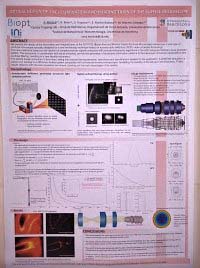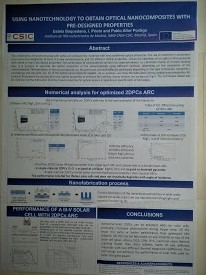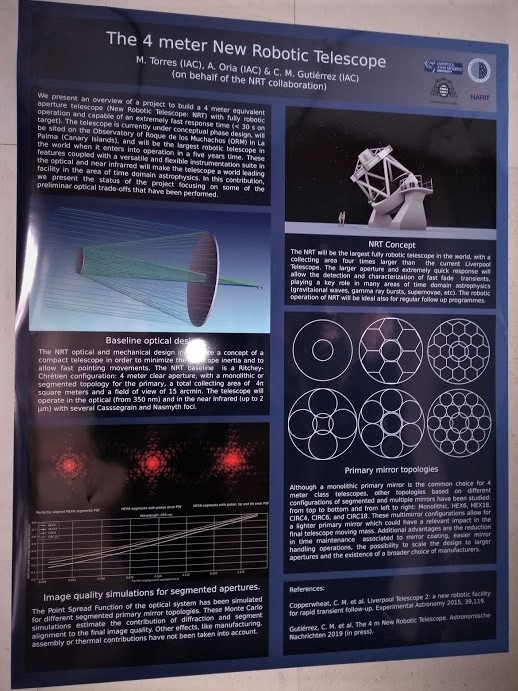
|
|
|
Posters from ESODM-2019 |
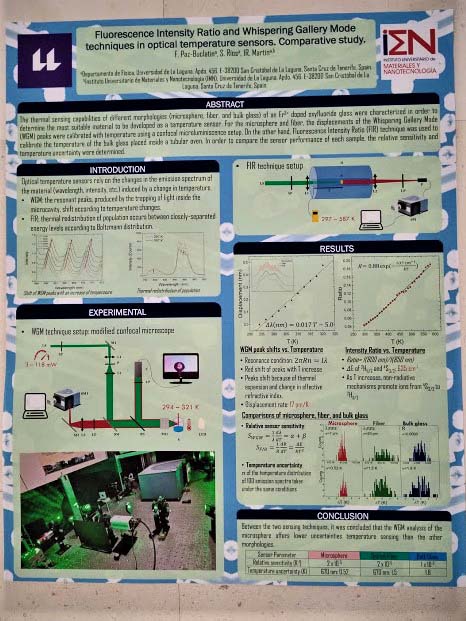
Fluorescence Intensity Ratio The thermal sensing capabilities of different morphologies (microsphere, fiber, and bulk glass) of an Er3+ doped oxyfluoride glass were characterized in order to determine the most suitable material to be developed as a temperature sensor. For the microsphere and fiber, the displacements of the Whispering Gallery Mode (WGM) peaks were calibrated with pump power and temperature using a confocal microluminiscence setup. WGM are resonances of a wave field inside a cavity due to the successive total internal reflections on its curved surfaces. The resonance condition depends on the dimension and refraction index of the cavity, which in turn are dependent on the temperature through the thermal expansion coefficient and thermo-optic coefficient, respectively. On the other hand, Fluorescence Intensity Ratio (FIR) technique was used to calibrate the temperature of the bulk glass placed inside a tubular oven. This technique consists of analyzing the fluorescence intensity of thermally coupled energy levels wherein a thermal redistribution of population occurs as the temperature of the material varies. In order to compare the sensor performance of each sample, the relative sensitivity and temperature uncertainty were determined. A relative sensitivity of 9.9 x 10-5 K-1 was obtained for the microsphere and the fiber and 1.0 x 10-2 K-1 for the bulk glass, a value two orders of magnitude greater than that of the microresonators. On the other hand, the microsphere and fiber presented temperature uncertainties for the 670 nm emission band an order of magnitude lower than that of the bulk glass: 0.11 K, 0.37 K, and 1.8 K respectively. The results of this study facilitate the selection of the morphology of an optically active material and the corresponding sensing method to be employed in the development of an optical temperature sensor.
In this work we present a novel application in the field of shoulder-surfing
prevention by using a light-field display consisting of a multilayered
structure of LC screens. By controlling the directionally displayed content,
we can discriminate between authorized and unauthorized observers.
Optimizations regarding different parameters were assessed, i.e, number of
unauthorized/authorized observers, quality and complexity of the contents,
and physical limitations. Tests were made in simulations and a real model
implementation.
Optical Design of the Illumination
We present the design of the illumination and imaging trains of the SUFFICE (Super-Fast and Flexible Digital Confocal Microscope) microscope: a new type of confocal microscope specially designed for a new microscopy technique based on acousto-optic deflectors (AOD) under protected technology. This new method is based on the injection of complex acoustic signals computed with acousto-holographic algorithms to the AOD using and arbitrary wave generator (AWG). This procedure, in combination with virtual pinholing, permits the generation of structured illumination patterns for fluorescence microscopy applications with confocal filtering, resulting in a very flexible instrument. The optical design procedure is described, taking into account the requirements, restrictions and specifications needed for the application. A ZEMAX® simulation is carried out, leading to a diffraction-limited system compatible with commercial inverted microscopes, facilitating the building of the set-up in the laboratory. Finally, results obtained with the new apparatus are shown, pointing out the main advantages of the system.
Refractive index characterization
In this paper, we present a new technique that allows mapping the refractive index of an organic tissue as a method to characterize its density. Here, mice brain slices stained against Tyrosine Hidroxylase (TH) enzyme and revealed with a Cy2 immunofluorescent secondary antibody were introduced in a Fabry-Perot (FP) microcavity, acting as a photonic structure. This cavity is formed by two parallel fused silica plates covered with dichroic Bragg Reflectors (BR) with a separation of 60 microns. The BRs were obtained by a multilayer deposition of Nb2O5/SiO2 thin films. They were designed to reach high reflection in the green region, while showing great transparency in the blue or in the infrared (IR) spectral, facilitating the use of organic dyes that tent to show green emission.
Using Nanotechnology to
The combination of nanotechnology with optics can produce new materials with new predefined optical properties. The use of materials in nanometric sizes favors the integration of them in a new nanocomposite, and the different optical properties allows the obtention of an optical nanocomposite with mixed or even new optical properties. The combination of nanomaterials can be in an ordered manner, as a photonic crystal, or in more random way. It is possible to calculate the optical properties of the nanocomposite using different methods, depending on the complexity of the nanocomposite. The fabrication of the nanocomposite can be performed also with different techniques depending on the type (nanowires, nanopillars, nanolayers) and size (mm, cm, m) of the optical nanocomposite needed . As an example, we show the fabrication of new optical nanocomposites for confocal fluorescent microscopy with new optical properties to enhance the intensity and to remove the background light. The techniques shown can be used also for the fabrication of optical nanocomposites for optical sensors in satellites or specific parts of telescopes.
M. Torres and A. Oria
We present an overview of a project to build a 4 meter diameter telescope (New Robotic Telescope: NRT) with fully robotic operation. The telescope will be sited on the Observatory of Roque de los Muchachos (ORM) in the island of La Palma (Spain). The project is currently in a conceptual phase design and when it enters into operation in five years time, NRT will be the largest robotic telescope in the world. This, in conjuction with an extremely fast response (< 30 s) and a versatile and flexible instrumentation in the optical and near infrared ranges will make NRT a world leading facility in the area of time domain astrophysics. In this contribution, we present the status of the project and focus on some of the technical challenges in optics, mechanics and electronics associated with the special operation of the telescope. |
| ® 2019 Kidger Optics Associates. All rights reserved. |

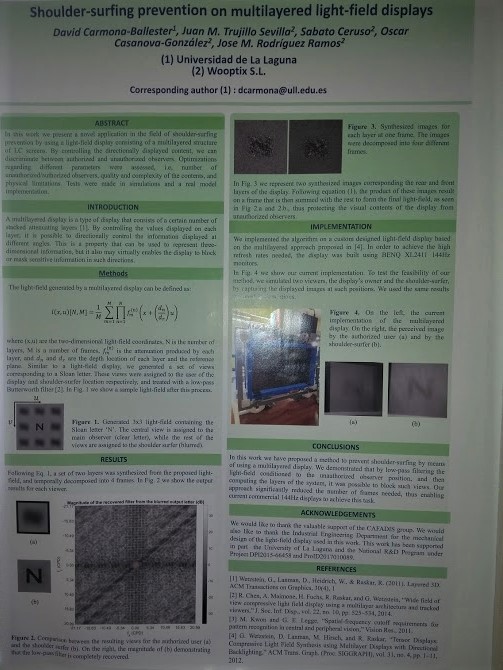 Shoulder-surfing prevention on
Shoulder-surfing prevention on